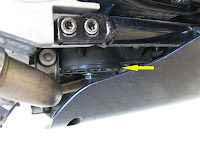 |
| The Blue Beast - Oiled Up and Ready to Go... |
My first question was “does the fairing have to come off to accomplish an oil change?” The answer is no – it doesn’t. I did a complete (and fairly easy) job tonight without even loosening a fairing screw. No problem.
 |
| Free advert for Lucas... |
I am embarrassed to say that the oil I just drained has been in the engine for about two years. I guess it looked really good for two-year-old oil but jeesh… It didn't have that many miles on it but we won't be letting things go that long next time, now will we...
 |
| Side View |
 |
| Rear drain plug and the filter assy |
I removed the rear drain plug and the filter assembly and I let the
oil drain for a while during which time I had a cold one. Those who know me well understand this means
a Diet Coke…
Then, there is a second drain plug (third if you count the filter assembly) further forward, up underneath the cowl (starboard side as you sit on the bike). There is a lower side port in the fairing through which you can see this bolt/drain-plug and you can reach up from underneath with your ratchet to get on it. I had to use a longer extension for that one. Take a look at this one and mark its position well – it is very hard to see its location under there when it comes time to put it back in place if you haven't been careful about that.
 |
| Forward drain plug |
So while
this one drains for a while, I take the filter assembly over to the work bench
and pull it apart. I used some spray solvent on it to clean it up and
replaced the o-rings on the shaft and the mounting plate. Then you re-assemble it
by sliding the mounting plate over the center shaft, dropping the spring and
the washer over the center shaft, push the new element down onto those, and set
the metal top flange over the element.
Smear some oil on the o-rings – and it is ready to go back on the bike; piece of cake.
 |
| Forward drain plug |
I added four quarts to start, then started the engine for a few moments to move the oil back into the places it needed to go. Once that happened, I shut him down and added the last little bit of oil needed to bring the level up to the proper point on the sight-glass (make sure the bike is level). Take care – add only a little at a time until it is about ½ to ¾ between the low line and high line on the sight gauge. Do not overfill it or the Earth will tilt off its axis and careen into the Sun. Old Blue took a little over 4 quarts total today - not even close to 5 quarts.
That’s it. Clean up the oil you spilled all over the
floor, throw away your trash and wipe off your tools and put them back where
they belong. Go wash your hands with
some Goop or Lava and feel like you accomplished something worthwhile. Or better yet, take the brute for a spin up
the road and see how great it feels to have new, slippery oily-oil in your scoot!
It's spring, you know? It's time to go for a ride.
Just keep it between the fence posts!
Updated April 14, 2013
It's spring, you know? It's time to go for a ride.
Just keep it between the fence posts!
Updated April 14, 2013

